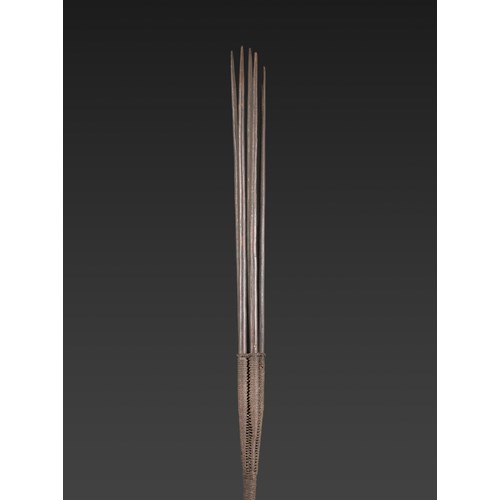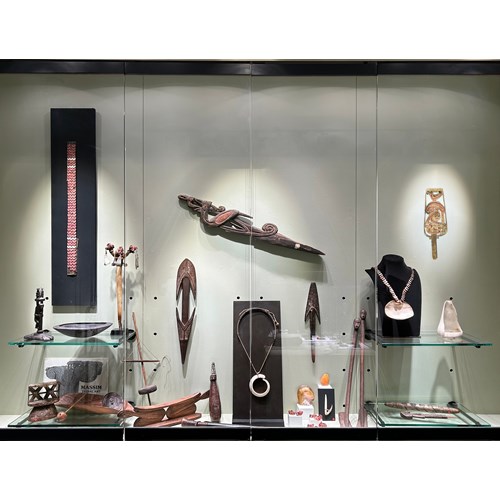Santa Cruz Fishing Float
Epoque 19th/20th century
Origine Santa Cruz Islands, Solomon Islands, Polynesian Outliers
Medium Wood, pigment, turtle shell, stone, bush fiber and bush string with a patina of age and usage.
Dimension 33 cm (13 inches)
Ex coll. : Jacques Lebrat, Paris.
Epoque: 19th/20th century
Origine: Santa Cruz Islands, Solomon Islands, Polynesian Outliers
Medium: Wood, pigment, turtle shell, stone, bush fiber and bush string with a patina of age and usage.
Dimension: 33 cm (13 inches)
Provenance: The Santa Cruz Islands fishing apparatus known as Teu Malimba (*2), used for catching flying fish, has been documented for a long time. It has a wooden float variously decorated with ornaments, a stone sinker, a tree bast line and a toggleshaped turtle shell hook, and was still in use in 2005. Koch collected the illustrated fishing implements as well as the toggle shaped turtle shell hooks during his stay on the main island of dende. (26): Ill. 30. Fisherman Alfred Lea affirmed that he still used them. Koch states: "The fisherman goes out onto the high seas with several floats, baits the hooks with crab claw meat, and casts them into the water one after another. Weighted by stone sinkers, the floats are vertical in the water, and therefore the upper part remains visible above the water's surface, to the fisherman." The simple unweighted wooden cylinders that Koch did not observe were still used to catch flying fish in 2005.
The first illustration of the Santa Cruz Islands float appears in Codrington's "The Melanesians" in 1891 (*2). The wooden float here is also decorated with engravings. Although it would appear obvious that the fishermen used these marks to identify their equipment, Beasley quotes a Santa Cruz mission boy saying: "that the marks upon them are not ownership marks, but serve to indicate the order in which they are placed in the sea, for they do not throw them in anyhow, but place them in proper sequence. The one with the human figure upon it, he supposed, would be the first, and probably represents the spirit who has charge of the flying fish."
Excerpt from Blau, Daniel; Maaz, Klaus : FISHHOOKS of THE PACIFIC ISLANDS
Literature: Ref. :
Blau, Daniel; Maaz, Klaus : FISHHOOKS of THE PACIFIC ISLANDS. Daniel Blau, Munich & London, 2012, p. 124/125, Fig. 43.
Meyer, Anthony JP : OCEANIC ART. Könemann Verlage, Köln, 1995, p. 599, fig. 639
The Santa Cruz Islands fishing apparatus known as Teu Malimba (*2), used for catching flying fish, has been documented for a long time. It has a wooden float variously decorated with ornaments, a stone sinker, a tree bast line and a toggleshaped turtle shell hook, and was still in use in 2005. Koch collected the illustrated fishing implements as well as the toggle shaped turtle shell hooks during his stay on the main island of dende. (26): Ill. 30. Fisherman Alfred Lea affirmed that he still used them. Koch states: "The fisherman goes out onto the high seas with several floats, baits the hooks with crab claw meat, and casts them into the water one after another. Weighted by stone sinkers, the floats are vertical in the water, and therefore the upper part remains visible above the water's surface, to the fisherman." The simple unweighted wooden cylinders that Koch did not observe were still used to catch flying fish in 2005.
The first illustration of the Santa Cruz Islands float appears in Codrington's "The Melanesians" in 1891 (*2). The wooden float here is also decorated with engravings. Although it would appear obvious that the fishermen used these marks to identify their equipment, Beasley quotes a Santa Cruz mission boy saying: "that the marks upon them are not ownership marks, but serve to indicate the order in which they are placed in the sea, for they do not throw them in anyhow, but place them in proper sequence. The one with the human figure upon it, he supposed, would be the first, and probably represents the spirit who has charge of the flying fish."
Excerpt from Blau, Daniel; Maaz, Klaus : FISHHOOKS of THE PACIFIC ISLANDS
See the example inv. n° FE001436 acquired in 1916 in the Te Papa National Museum, Wellington, New Zealand (https://collections.tepapa.govt.nz/object/165432)
Plus d'œuvres d'art de la Galerie









